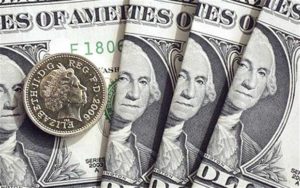 Yesterday’s trade saw GBP/USD within the range of 1.4106-1.4219. The pair closed at 1.4194, rising 0.55% compared to Tuesdays close. It has been the 25th gain in the past 59 trading days and also the steepest one since June 7th. The major pair has fallen 2.09% so far in June, following a 0.92% drop in the prior month.
Yesterday’s trade saw GBP/USD within the range of 1.4106-1.4219. The pair closed at 1.4194, rising 0.55% compared to Tuesdays close. It has been the 25th gain in the past 59 trading days and also the steepest one since June 7th. The major pair has fallen 2.09% so far in June, following a 0.92% drop in the prior month.
At 6:23 GMT today GBP/USD was edging down 0.18% on the day to trade at 1.4169. The pair touched a daily high at 1.4213 during the early phase of the Asian trading session, undershooting the daily R2 level, and a daily low at 1.4160 at 5:28 GMT.
On Thursday GBP/USD trading may be influenced by the following macroeconomic reports and other events as listed below.
Fundamentals
United Kingdom
Retail Sales
Annualized retail sales in the United Kingdom probably rose at a rate of 3.9% in May, according to the median forecast by experts, after in April sales increased by another 4.3%. The latter has been the fastest annual rate of increase since January, when the general index was reported to have risen at a revised up 5.4%. If expectations were met, May would be the 38th consecutive month of sales growth.
In monthly terms, retail sales probably went up 0.2% in May, according to market expectations. In April retail sales surged 1.3%, or at the fastest monthly rate since January, when the indicator rose at an unrevised 2.3%. Aprils index performance came as a result of higher sales at all shop types with the exception of textiles, clothing and footwear.
Annualized retail sales, without taking into account fuel sales, probably surged 3.8% in May, following a 4.2% increase in April. The latter has been the fastest annual rate of increase since January. If expectations were met, May would be the 49th consecutive month of growth in annual core sales.
Retail sales represent a short-term indicator, which provides key information about consumption on a national scale. Higher retail sales suggest stronger consumer demand, confidence and economic growth, respectively. Therefore, in case the general index of retail sales increased at a faster-than-expected rate, this would have a strong bullish effect on the Pound. The Office for National Statistics is expected to publish the official report at 8:30 GMT.
Bank of England policy decision
At 11:00 GMT Bank of England is to announce its decision on monetary policy. The benchmark interest rate (repo rate) will probably be left unchanged at the record low level of 0.50%. The rate has been at that level since BoEs policy meeting on March 5th 2009. The repo rate applies to open market operations of the central bank with other banks, building societies, securities firms etc.
At the same time, the pace of BoE’s monetary stimulus will probably be left without change as well, at GBP 375 billion. The asset-purchasing program, financed by the issuance of central bank reserves was initiated on March 5th 2009, while the scale of this program was increased by GBP 50 billion to the current GBP 375 billion on July 5th 2012.
The minutes from the Banks policy meeting held on May 12th revealed that all 9 members of the Monetary Policy Committee voted in favor of keeping borrowing costs and the stock of purchased assets intact. Policy makers revised down growth projections, stressing on that uncertainty associated with the June 23rd referendum has started to adversely affect economic activity. UK economy is now expected to grow 0.3% in Q2 2016, down from a 0.5% expansion as previously estimated, which trimmed the annual forecast by 20 basis points to 2%. In addition, UK GDP forecast for 2017 and 2018 was revised down by 10 basis points to 2.3%. At the same time, annual consumer inflation forecast was left unchanged, pointing to a 0.4% in 2016.
According to extracts from the Banks Monetary Policy Statement, released on May 12th: ”In the United Kingdom, activity growth slowed in Q1 and a further deceleration is expected in Q2. There are increasing signs that uncertainty associated with the EU referendum has begun to weigh on activity.”
”… the MPC judges that it is more likely than not that Bank Rate will need to be higher by the end of the forecast period than at present to ensure inflation returns to the target in a sustainable manner. All members agree that, given the likely persistence of the headwinds weighing on the economy, when Bank Rate does begin to rise, it is expected to do so more gradually and to a lower level than in recent cycles. This guidance is an expectation, not a promise.”
”The most significant risks to the MPC’s forecast concern the referendum. A vote to leave the EU could materially alter the outlook for output and inflation, and therefore the appropriate setting of monetary policy. Households could defer consumption and firms delay investment, lowering labour demand and causing unemployment to rise.”
”Whatever the outcome of the referendum and its consequences, the MPC will take whatever action is needed to ensure that inflation expectations remain well anchored and inflation returns to the target over the appropriate horizon.”
United States
Initial, Continuing Jobless Claims
The number of people in the United States, who filed for unemployment assistance for the first time during the business week ended on June 10th, probably rose to 270 000, according to market consensus, from 264 000 in the preceding week. The latter has been the lowest number of claims since the business week ended on April 22nd, when an unrevised level of 257 000 was reported.
The 4-week moving average, an indicator lacking seasonal effects, was 269 500, marking a decrease by 7 500 compared to the preceding weeks revised up average.
The business week, which ended on June 3rd has been the 66th consecutive week, when jobless claims stood below the 300 000 threshold, which suggested a healthy labor market. It has been the longest streak in 43 years.
Initial jobless claims number is a short-term indicator, reflecting lay-offs in the country. In case the number of claims met expectations or increased further, this would have a moderate bearish effect on the US dollar.
The number of continuing jobless claims probably rose to the seasonally adjusted 2 120 000 during the business week ended on June 3rd, according to the median forecast by experts, from 2 095 000 in the preceding week. The latter has been the lowest number of claims since the business week ended on October 20th 2000. The figure also represented a decrease by 77 000 compared to the unrevised number of claims reported in the week ended on May 20th. This indicator reflects the actual number of people unemployed and currently receiving unemployment benefits, who filed for unemployment assistance at least two weeks ago.
The US Department of Labor is to release the weekly report at 12:30 GMT.
Consumer Price Inflation
The annualized consumer inflation in the United States probably remained at 1.1% for a second straight month in May, according to market expectations. In March annual consumer prices rose 0.9%, or at the lowest rate since December 2015. In monthly terms, the Consumer Price Index (CPI) probably rose 0.3% in May, following a 0.4% surge in the preceding month.
In April, cost of services less energy went up 3.0% year-on-year, or at the same rate as in March). Within the category, cost of shelter went up 3.2% year-on-year, or matching the rate in March, while cost of medical care rose 3.1%, following a 3.6% surge in March. Additionally, consumers paid more for food in April (up at an annualized rate of 0.9%, accelerating from a 0.8% surge in March) and transportation services (up 3.3% year-on-year and following a 2.8% increase in March), according to the report by the Bureau of Labor Statistics. The largest downward pressure on the annual CPI came from prices of energy (down 8.9% in April from a year ago, or a less steep decline compared to March).
The annualized core consumer inflation, which is stripped of prices of food and energy, probably accelerated to 2.2% in May, according to expectations, from 2.1% in April. The latter has been the lowest core inflation since December 2015.
If the general CPI tends to approach the inflation objective, set by the Federal Reserve and considered as providing price stability, or a level below but close to 2%, this will usually bolster the appeal of the US dollar, as it heightens the probability of monetary policy tightening.
The Bureau of Labor Statistics is to release the official CPI report at 12:30 GMT.
Philadelphia Fed Manufacturing Index
The Philadelphia Fed Manufacturing Index probably improved to a reading of -1.3 in June, according to an estimate by TradingEconomics.com, after unexpectedly falling to a reading of -1.8 in May. The latter has been the lowest index reading since February, when the gauge was reported at -2.8.
A level above zero is indicative of improving business conditions, while a level below zero is indicative of worsening conditions. In case the index rose more than projected in June, this would have a moderate bullish effect on the US dollar. The Federal Reserve Bank of Philadelphia is expected to release the official results from the survey at 12:30 GMT.
NAHB Housing Market Index
The National Association of Home Builders (NAHB) Housing Market Index probably rose to 59.0 in June, according to market expectations, after remaining at a level of 58.0 in the prior four months. If so, June would be the 24th consecutive month, when the gauge stood in the area above 50.0.
The indicator is based on a monthly survey in regard to current home sales and expected sales in the coming six months. Values above the key level of 50.0 indicate that housing market conditions are good. Therefore, higher-than-projected readings would provide a moderate support to the US dollar. The official report is scheduled for release at 14:00 GMT.
FOMC abstains from action, reduces GDP growth forecasts
Yesterday the Federal Open Market Committee kept the target range for the federal funds rate on hold at 0.25%-0.50% for a fourth time this year, as largely expected. US economy is now expected to grow 2% in 2016, down from 2.2% as expected in March, and by another 2% in 2017, down from 2.1% in the previous forecast. On the other hand, PCE inflation forecast was revised up to 1.4% in 2016 (from 1.2% as expected in March), while the 2017 forecast was left unchanged at 1.9%.
Daily, Weekly and Monthly Pivot Levels
By employing the Camarilla calculation method, the daily pivot levels for GBP/USD are presented as follows:
R1 – 1.4204
R2 – 1.4215
R3 (range resistance) – 1.4225
R4 (range breakout) – 1.4256
S1 – 1.4184
S2 – 1.4173
S3 (range support) – 1.4163
S4 (range breakout) – 1.4132
By using the traditional method of calculation, the weekly pivot levels for GBP/USD are presented as follows:
Central Pivot Point – 1.4360
R1 – 1.4543
R2 – 1.4828
R3 – 1.5011
S1 – 1.4075
S2 – 1.3892
S3 – 1.3607
In monthly terms, for GBP/USD we have the following pivots:
Central Pivot Point – 1.4526
R1 – 1.4722
R2 – 1.4966
R3 – 1.5162
S1 – 1.4282
S2 – 1.4086
S3 – 1.3842





